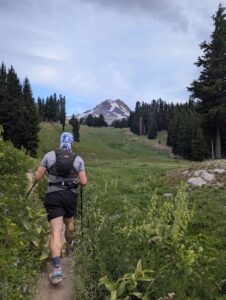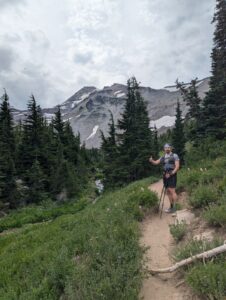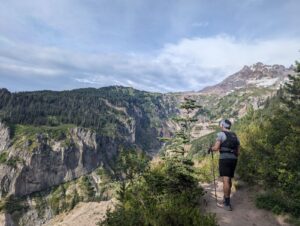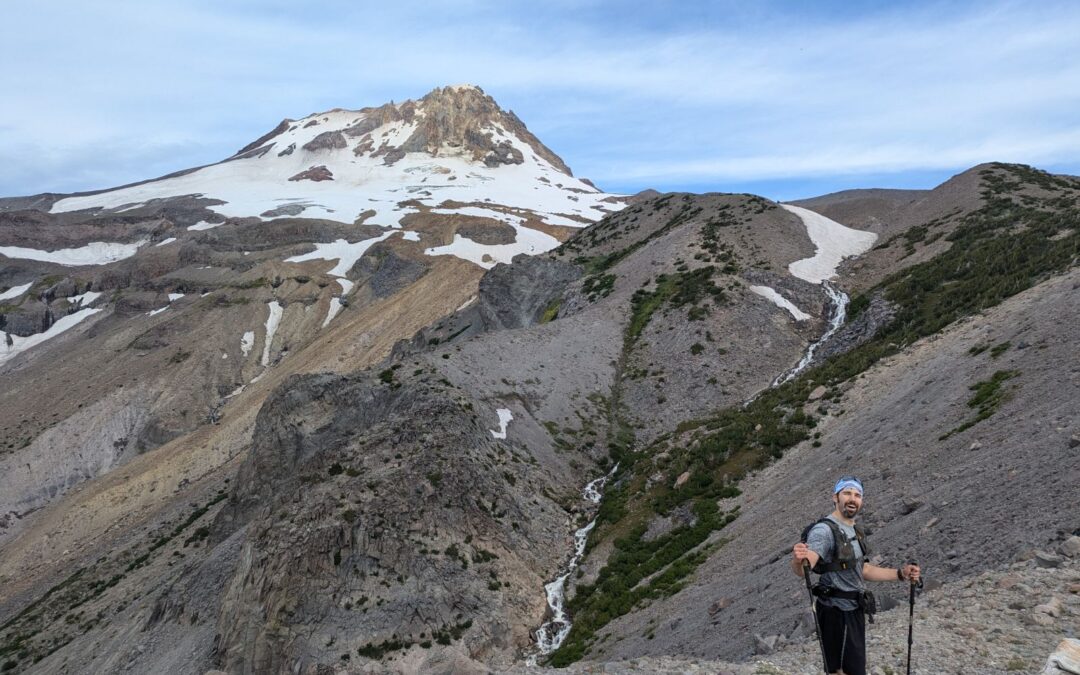 This is a perspective blog posting about my experience with running and the training process that I found to be helpful on my journey. As a physical therapist, I hope to share some of my experiences with you about running progressions, load management, selected exercises, and other helpful tips that helped me safely reach my goal of circumnavigating Mt. Hood this past Summer without injury.
This is a perspective blog posting about my experience with running and the training process that I found to be helpful on my journey. As a physical therapist, I hope to share some of my experiences with you about running progressions, load management, selected exercises, and other helpful tips that helped me safely reach my goal of circumnavigating Mt. Hood this past Summer without injury.
I have been a “non-runner” my whole life, however, having played various sports historically, I have managed to keep a basic level of fitness. This often meant that I made it to the gym 2-3x/week. I realized Fall of 2023 that I needed a good long term goal that I could train for…something that would require training to achieve and in the process reap some health benefits for my cardio. And so, the 42 miles around Mt. Hood’s Timberline Trail sounded like the perfect goal.
Setting a Goal
SMART goals: Specific, Measurable, Attainable, Realistic, Timely
This is a good framework to use while self-guiding or assisting someone else with the pursuit of a goal.
Seek to have each of these “SMART” components figured out before embarking on your journey.
For my example, the SMART goal was to complete the 42 miles of the Timberline Trail, with my cousin, in Early August, in less than 16 hours.
The process of achieving a long term goal can have many trials and this journey certainly did, but setting a “SMART” goal helped keep me anchored to my mission when things got more difficult.
 Have a Plan
Have a Plan
With limited running experience, I knew that I would probably benefit from a templated training plan to help guide me with my month to month progressions. I figured that before attempting to hike/jog 42 miles in one day, that I should at least have the aerobic (“cardio”) capacity that allows for me to run a marathon distance without stopping. In my mind, these two things might be close to equivalent….
After realizing this, I did some online searches for training plans and eventually found a 50K (31 miles) training plan on marathonhandbook.com. This was helpful!
The plan I selected outlined 26 weeks of training, Monday through Sunday, gradually progressing and with built in rest days. Since I had October to August to train, I knew that this plan gave me plenty of time to follow along and make adjustments as needed along the way. Despite my best efforts, I did fall off track at times. It was in these moment that I found it to be very helpful to refer back to the outlined plan.
Load Management
Gradual progressions in running performance mirrored my progressions in strength training at the gym. With patience, your body will adapt to increasing demands over time. Keeping track of distances ran, weights lifted, and pacing during a run, all helped me manage “load” on the body. I chose to make sure that I was doing heel raises with progressively heavier weights and to prevent other areas from creeping in as a potential issue by I targeting other large muscle groups for strengthening. The equipment at the local gym allowed for me to do this using dumbells and machines. My strengthening program was very simple and consisted of single leg press, knee extension machine, knee flexion machine, hip abduction machine, single leg heel raises, and hip extension machine. My goal each week or two was to make sure the load was continuing to gradually increase with these, even if that meant less sets and/or less reps. This helped make me a much stronger runner than before and I only needed to strength train one day / week!
 Accountability
Accountability
At the end of the day, whether it is doing your daily workout or brushing your teeth, we are each ultimately responsible for putting the work in to get the desired results. That being said, a support system is helpful! As a PT, I am often told by my patients that having an appointment helps them stay on track with their exercises throughout the week, just because they know I am going to ask them if they have been doing them regularly!
Similarly, as a new runner, I found it to be very helpful to have a couple of training partners. The weekly meetings for running together and socialization helped elevate the consistency of my performance while training.
Nutrition
When it comes to training tips that I can provide, proper nutrition is near the top of the list for long bouts of activity! For bouts of activity greater than one hour, maintaining a steady fuel source can be the difference between “hitting the wall” and standing tall atop the mountain. Essentials like water, electrolytes/salts (sodium, magnesium, calcium, potassium) and sugars are fairly well known to be helpful, but alone are low in calories. It was eye opening to me how helpful caloric intake was, but it is somewhat obvious retrospectively! I had to learn it the hard way.
I strongly recommend practicing consuming calories while running. For very long bouts of activity, foods that I liked included: Belvitta crackers, Stinger Stroopwaffels, and trail bars. Nutrition in the form of gels and blocks were very helpful and, while hit or miss with their flavor options, did tend to sit well with the stomach. Typically, I would eat the more complex foods earlier in the long bouts of activity and then shift gradually more and more toward the simple foods like gels and blocks. The stomach tended to handle this better!
Give Yourself Some Grace
Regardless of what your goal is, if you fall off track, not all hope is lost! Inevitably, life’s circumstances get in the way of some plans, or perhaps pains get in the way at times. As I ran regularly and maintained a routine for several weeks in a row, I found that keeping a big picture perspective helped to prevent panic of falling behind in training. I remember often thinking to myself that as long as the trend is showing improvements, then I am doing good work. Resting a little more when things feel too painful after a “progression week” is recommended, and by building rest days into the typical training week helps reinforce the importance of less active days.
With these concepts and tools, I was able to complete my “time trial” of circumnavigating Mt. Hood in about 15 hours, a feat that I never could have completed without the training this past year.
Hopefully some of this has been helpful! Even if its not running, many of these concepts can be applied to other personal goals. Consider your big picture goal and then work backwards to determine the best way to reach the outcome you seek. Then go do it!
If you need assistance or get stuck on your journey, you can always reach out to our team of therapists at MCOPT to achieve your goal. We’d love to help out!
Gear List
Shoe: Brooks Cascadia shoes
Sock: Rahhint (bought mine on Amazon)
Hydration Vest: Swiftland 5 hydration vest

